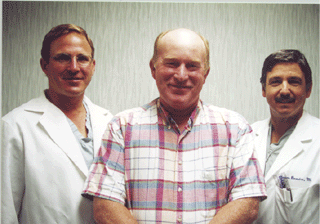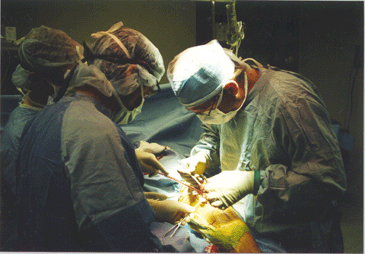CARTILAGE TRANSPLANT SURGERY
 On
March 29, 2000 Thomas Brandon, MD and Eric Franks, MD
made history at Peninsula Regional Medical Center.
During an operation that morning, the two Orthopaedic Surgeons performed
the Medical Center’s first Cartilage Transplant
surgery, a procedure mastered by less than 10 percent of all surgeons here in
the United States. “It was clockwork surgery,” said Dr. Franks.
“Everything happened exactly as we had trained for and exactly as we
had expected.” Drs. Brandon
and Franks are the only physicians performing the operation in our region. On
March 29, 2000 Thomas Brandon, MD and Eric Franks, MD
made history at Peninsula Regional Medical Center.
During an operation that morning, the two Orthopaedic Surgeons performed
the Medical Center’s first Cartilage Transplant
surgery, a procedure mastered by less than 10 percent of all surgeons here in
the United States. “It was clockwork surgery,” said Dr. Franks.
“Everything happened exactly as we had trained for and exactly as we
had expected.” Drs. Brandon
and Franks are the only physicians performing the operation in our region.
 The
procedure, which requires a full month of preparation, is nothing short of
amazing. It begins when surgeons
remove, arthroscopically, healthy cartilage from a portion of the knee near an
area that has been damaged by a trauma, sports, or occupational injury.
In this case, that cartilage was from the left knee of 47-year-old Fred
Moore of Allen, Maryland. That
healthy sample was sent to the Genzyme Corporation Lab in Cambridge,
Massachusetts. Scientists there
actually used that sample to “grow” new cartilage cells over a period of
three weeks. Those new cartilage
cells were then returned to Drs. Brandon and Franks who performed an “open”
knee surgery and injected them back into the small, injured portion of Mr.
Moore’s knee after removing the damaged cartilage from the area.
The new cells introduced into the knee were covered by a layer of soft
tissue removed from an area on Mr. Moore’s lower left leg.
The tissue was used to hold the cells in place until they attach
themselves to the bone, growing new cartilage in the process. The
procedure, which requires a full month of preparation, is nothing short of
amazing. It begins when surgeons
remove, arthroscopically, healthy cartilage from a portion of the knee near an
area that has been damaged by a trauma, sports, or occupational injury.
In this case, that cartilage was from the left knee of 47-year-old Fred
Moore of Allen, Maryland. That
healthy sample was sent to the Genzyme Corporation Lab in Cambridge,
Massachusetts. Scientists there
actually used that sample to “grow” new cartilage cells over a period of
three weeks. Those new cartilage
cells were then returned to Drs. Brandon and Franks who performed an “open”
knee surgery and injected them back into the small, injured portion of Mr.
Moore’s knee after removing the damaged cartilage from the area.
The new cells introduced into the knee were covered by a layer of soft
tissue removed from an area on Mr. Moore’s lower left leg.
The tissue was used to hold the cells in place until they attach
themselves to the bone, growing new cartilage in the process.
Mr.
Moore was on crutches roughly six weeks and full recovery, with specialized
rehabilitation, should take four to six months.
The reported success rates range from 75 to 90 percent. Candidates for the surgery are customarily 20 to 50 years old
and must have no evidence of arthritis in the knee. The surrounding cartilage
must be healthy. The damaged area
can not be larger than 10 to 12 square centimeters in diameter and should be
located at the end of the femur (thigh bone) where that specific cartilage
allows smooth, low friction movement and provides cushion to the joint.
“When
cartilage is damaged it dies and does not grow again on its own, creating a
friction point on the bone that patients describe as a very painful
‘gravel-like’ grinding feeling. The
surgery was developed to treat a person, like Mr. Moore, who has injured a small
portion of the cartilage in their knee and is intended to relieve pain and
possibly help to prevent arthritis from occurring 10 to 15 years down the
road,” said Dr. Brandon. “This
is not a cure for arthritis or recommended for anyone suffering from
arthritis.”
Drs.
Brandon and Franks believe there are numerous patients in the region who meet
the criteria and could be treated with this new Cartilage Transplant surgery.
For more information, you can call Peninsula Orthopaedic Associates, P.A.
in Salisbury at 410-749-4154.
“Prior to
the surgery, it was impossible to walk without pain.
Now that I’m off the crutches and walking on the leg again, I don’t
have any of the pain that I felt before. My
recovery is going smoothly and I’m told I’m actually ahead of schedule with
the physical therapy." Fred Moore, Cartilage Transplant Patient,
Allen, Maryland pictured above with Drs. Franks, left, and Brandon,
right.
|